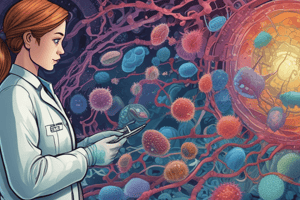Podcast
Questions and Answers
What are infectious protein particles called?
What are infectious protein particles called?
Prions
What does reverse transcriptase synthesize?
What does reverse transcriptase synthesize?
DNA from RNA
What term is more appropriate rather than saying a virus is alive?
What term is more appropriate rather than saying a virus is alive?
Active
Which of the following options are correct regarding viral nucleic acids? (Select all that apply)
Which of the following options are correct regarding viral nucleic acids? (Select all that apply)
Which of the following are host cells of viruses? (Select all that apply)
Which of the following are host cells of viruses? (Select all that apply)
What are virus capsids made from?
What are virus capsids made from?
Two non-cellular agents smaller than viruses are infectious proteins called ___________ and the infectious RNA strands called ___________.
Two non-cellular agents smaller than viruses are infectious proteins called ___________ and the infectious RNA strands called ___________.
All of the following are located between the capsid and nucleic acid.
All of the following are located between the capsid and nucleic acid.
What is the primary purpose of viral cultivation? (Select all that apply)
What is the primary purpose of viral cultivation? (Select all that apply)
What protrudes from the viral envelope?
What protrudes from the viral envelope?
What does lysogeny refer to?
What does lysogeny refer to?
What are infectious naked strands of RNA that affect plants called?
What are infectious naked strands of RNA that affect plants called?
What are viral tissue specificities called?
What are viral tissue specificities called?
The core of every virus particle always contains __________ or __________.
The core of every virus particle always contains __________ or __________.
Flashcards are hidden until you start studying
Study Notes
Prions and Viroids
- Prions are infectious protein particles responsible for various neurodegenerative diseases.
- Viroids are infectious RNA strands that primarily affect plants, lacking a protein coat.
Reverse Transcriptase
- Reverse transcriptase is an enzyme that synthesizes DNA from RNA templates, crucial in retroviruses.
Virus Activity
- Instead of classifying viruses as living organisms, they are more accurately described as "active" when they can infect and replicate within host cells.
Viral Nucleic Acids
- Viral nucleic acids can include both DNA and RNA, which may be single-stranded or double-stranded, and can be segmented or non-segmented.
Host Cells
- Viruses can infect a wide range of host cells, including plants, animals, and bacteria (prokaryotes).
Capsomeres
- Virus capsids, the protective protein shells of viruses, are constructed from protein subunits known as capsomeres.
Virus Structure
- Viral structures often contain capsids that encase the genetic material, while some viruses have envelopes that contain viral spikes protruding from their surface.
Lysogeny
- Lysogeny is the process by which a viral genome integrates into a bacterial host chromosome, allowing the virus to persist without immediately destroying the host.
Viral Spikes
- Viral spikes are protein structures that protrude from the viral envelope, playing a key role in viral attachment to host cells.
Viral Cultivation
- The primary purpose of viral cultivation includes studying virus behavior, characteristics, and developing vaccines or treatments.
Tropisms
- Tropisms refer to the specific tissue or cell types that viruses preferentially infect, influencing pathogenicity and disease manifestations.
Viral Core
- Every virus particle contains a core that consists of genetic material, which can be either RNA or DNA, essential for the virus’s replication and propagation.
Studying That Suits You
Use AI to generate personalized quizzes and flashcards to suit your learning preferences.




